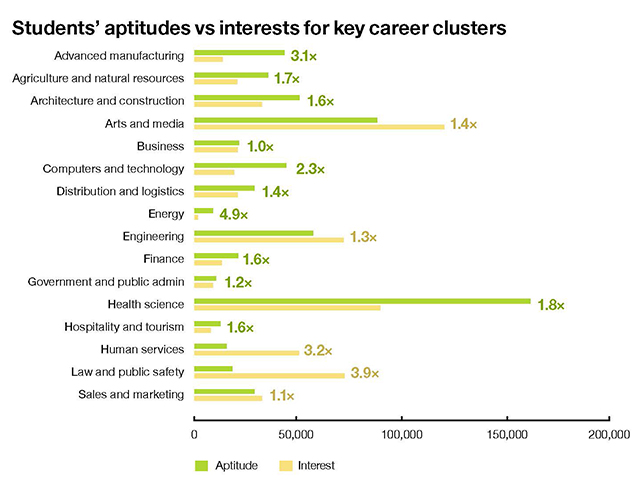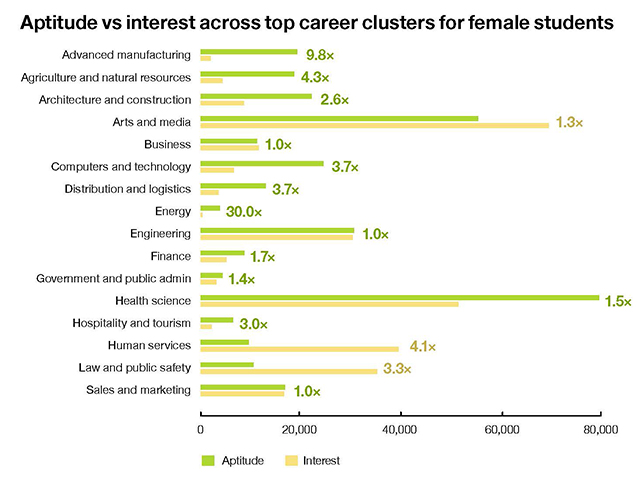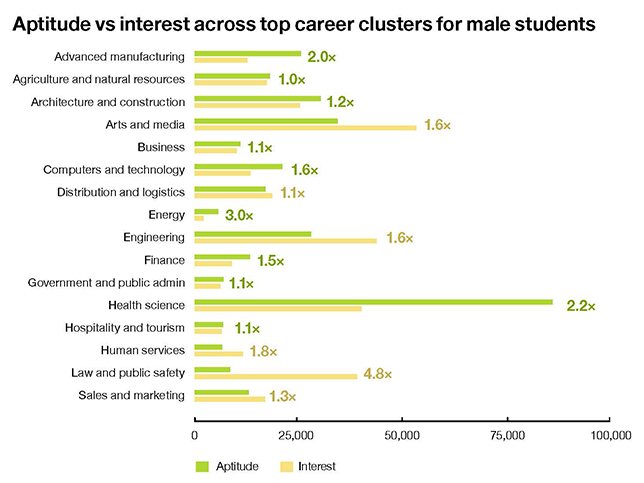Gap Between Students' Aptitudes and Their Career Interests Focus of New Report
YouScience Analysis of 238K Aptitude Assessments from 2021 Shows Need to Erase Career ‘Exposure Gap’
- By Kristal Kuykendall
- 07/27/22
U.S. students’ aptitudes far outweigh their interest in career clusters where significant job growth is forecast, revealing an exposure gap that will continue impacting the workforce as a skills gap unless schools can better help students find their “why” and then draw connections to related career options, according to a new study from student aptitude and career guidance platform YouScience.
The State of The Future U.S. Workforce: Student Ability Report, released this week by YouScience, is based on anonymized data from 239,843 high school students’ Discovery aptitude assessments completed during 2021, according to the report summary. The students represented by the data were from all 50 states, and almost evenly split between male (47%) and female (53%) students, YouScience said.
The analysis of the assessments reveals that “students have the aptitudes, or talent, to excel in today's in-demand jobs, but often lack interest in these fields, in some cases due to lack of knowledge about available careers,” the report said.

The YouScience Discovery aptitude assessment — available for individual student purchase and as a subscription for district-wide use — combines “psychometrically valid brain game-like exercises that uncover students’ aptitudes with an interest inventory,” the report said.
“Students must be better aligned to and prepared for the future needs of our workforce. We know students have the talent, but they are not being adequately exposed to the career pathways wherein they possess natural skills and where they have the most potential to thrive,” said YouScience CEO Edson Barton.
The gaps between aptitude and interest “tells us that what exists is less of a talent gap and more of an exposure gap, which results in a skills gap and a need to help students become more self aware of their potential for in-demand careers,” the report said. “For example, many students who are good at math can only identify a handful of potential job options from among the thousands that exist. “
Key Findings Showing Career Exposure Gaps
YouScience’s report revealed the following differences between what students said they were interested in and the areas in which they showed aptitude or talent:
- Students have nearly 5x more aptitude than interest in energy careers.
- Students have over 3x more aptitude than interest in advanced manufacturing careers.
- Students have over 2x more aptitude than interest for computer technology careers.
- Students have almost 2x more aptitude than interest in for health science careers.
The analysis also showed that gender biases still “need to be addressed to turn the corner on the exposure and skills gap challenges,” the report said, citing the following examples:
- Female students have 30x more aptitude than interest in energy careers.
- Female students have almost 4x more aptitude than interest in computer technology careers.
- Female students have almost 10x more aptitude than interest in advanced manufacturing careers, while male students have about 2x more aptitude than interest.


Recommendations for Educators & School Leaders
The YouScience report urged K–12 educators and administrators to “strengthen their investment in work-based learning initiatives” by focusing on programs that “ensure all learners understand their aptitudes and matching career opportunities and engage in coursework and programs that build on these abilities and certifications.”
Additional recommendations for educators and school leaders included:
Help students find their “why”: “When students discover their aptitudes, education becomes increasingly real and applicable,” the report noted. YouScience recommends that students begin taking aptitude assessments during middle school or early in high school.
Close the exposure gap and reveal opportunities: Aptitude assessments connect students to career options that fit their talents, expanding a student’s notion of what’s possible, the report said, leading to increased student engagement and opportunities to explore internships, summer jobs, and networking events.
Make education relevant using career-connected learning: YouScience recommends schools take advantage of career and technical education certification programs to help students connect what they learn in school with real-world jobs.
Enable connections between education and industry: “Schools need to embrace local industries and invite them into the student learning experience to expand students’ opportunities,” the report said. “Work-based learning and career-connected learning … along with apprenticeships and internships, help students see and find their place in industry.”
Learn more at YouScience.com.